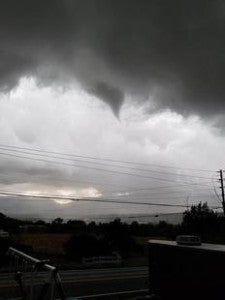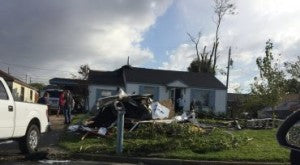My family lived in Tornado Alley for almost five years. We saw wall clouds and sheltered in place more times than we could remember. But my eldest son didn't see his first funnel cloud until he was walking to school Friday, near that hotbed for tornadoes ... American Fork, Utah.
[caption id="attachment_21059" align="alignright" width="225"]

Tornado forming in Utah - via Deseret News[/caption]
The tornado, which formed about 7:15 a.m. on September 23, was the
third to hit Utah in two days. The other two hit
near Ogden, Utah, about 61 miles away and
Panguitch, Utah, about 214 miles away, the day before. Utah averages about 2.5 tornadoes per year according to the web site
U.S. Tornadoes. In contrast,
Texas averages 146.7 per year and Kansas 92.4.
The tornado near Ogden,
an F1 on the enhanced Fujita scale, caused more than $1.5 million in damage and made more than a
dozen homes uninhabitable.
Every state and nearly every county in the United States has seen tornadoes.
Tornadoes can cross rivers, hills, and cities.
Numerous tornadoes have crossed the Mississippi River.
Elevation doesn’t matter. A hiker photographed a tornado at 12,000 feet in Sequoia National Park, Calif., on July 7, 2004. Tall buildings won’t stop tornadoes either. Downtown St. Louis has seen at least four tornadoes, according to NOAA. The Los Angeles Basin sees as many weak tornadoes per tens of square miles as the Great Plains.
Tornadoes mostly occur in the spring and summer. However, they hit every month of the year. “Tornadoes are like snowbirds — they winter in the South,”
according to an April 22 article in U.S. Tornadoes. In Utah, most tornadoes form
between May and September.
So, knowing a tornado can hit almost anywhere in the United States, even though it’s near the end of the summer tornado season, here are some reminders of how to prepare for one.
[caption id="attachment_21060" align="alignright" width="300"]

Damages from tornado in Utah - via Fox 13 News[/caption]
The most important way to prepare for a tornado is to learn when one is coming. A NOAA weather radio can post updates on all kinds of weather. They aren’t terribly expensive either, and
we have some that don’t need a plug, in case of power loss. On average, the National Weather Service issues tornado warnings 13 minutes prior to a hit, but warning times vary greatly. Therefore, the NWS emphasizes knowing the signs of a tornado. The following signs are
taken directly from the NWS.
- Strong, persistent rotation in a cloud base. (A cloud base looks like a rotating cylinder of clouds that descends below a storm.)
- Whirling dust or debris on the ground under a cloud base – tornadoes sometimes have no funnel.
- Hail or heavy rain followed by either dead calm or a fast, intense wind shift. Many tornadoes are wrapped in heavy precipitation and can't be seen.
- Day or night – Loud, continuous roar or rumble, which doesn't fade in a few seconds like thunder.
- Night – Small, bright, blue-green to white flashes at ground level near a thunderstorm (as opposed to silvery lightning up in the clouds). These mean power lines are being snapped by very strong wind, maybe a tornado.
- Night – persistent lowering from the cloud base, illuminated or silhouetted by lightning – especially if it is on the ground or there is a blue-green-white power flash underneath.
Second, have a plan and a place to go. That place can be in a home, in a personal storm shelter or in a public storm shelter. State Farm has a list of recommended places to go within homes and buildings.
Third, prepare a grab-and-go bag and personalize it with things like diapers and vital records. In the Washington Heights tornado near Ogden, one man told Utah’s Fox news affiliate that part of his home was destroyed and his neighbor’s garage blew over to his property. Hopefully he had a list of possessions and other vital information and hopefully he stored it away from his home or somewhere easy to grab. Vital information can include birth certificates, medical records and insurance information.
Fourth, be prepared for
more than just tornadoes. Many parts of Utah reported hail, power outages and flooding from the two-day storm.

 Tornado forming in Utah - via Deseret News[/caption]
The tornado, which formed about 7:15 a.m. on September 23, was the third to hit Utah in two days. The other two hit near Ogden, Utah, about 61 miles away and Panguitch, Utah, about 214 miles away, the day before. Utah averages about 2.5 tornadoes per year according to the web site U.S. Tornadoes. In contrast, Texas averages 146.7 per year and Kansas 92.4.
The tornado near Ogden, an F1 on the enhanced Fujita scale, caused more than $1.5 million in damage and made more than a dozen homes uninhabitable.
Every state and nearly every county in the United States has seen tornadoes.
Tornadoes can cross rivers, hills, and cities. Numerous tornadoes have crossed the Mississippi River.
Elevation doesn’t matter. A hiker photographed a tornado at 12,000 feet in Sequoia National Park, Calif., on July 7, 2004. Tall buildings won’t stop tornadoes either. Downtown St. Louis has seen at least four tornadoes, according to NOAA. The Los Angeles Basin sees as many weak tornadoes per tens of square miles as the Great Plains.
Tornadoes mostly occur in the spring and summer. However, they hit every month of the year. “Tornadoes are like snowbirds — they winter in the South,” according to an April 22 article in U.S. Tornadoes. In Utah, most tornadoes form between May and September.
So, knowing a tornado can hit almost anywhere in the United States, even though it’s near the end of the summer tornado season, here are some reminders of how to prepare for one.
[caption id="attachment_21060" align="alignright" width="300"]
Tornado forming in Utah - via Deseret News[/caption]
The tornado, which formed about 7:15 a.m. on September 23, was the third to hit Utah in two days. The other two hit near Ogden, Utah, about 61 miles away and Panguitch, Utah, about 214 miles away, the day before. Utah averages about 2.5 tornadoes per year according to the web site U.S. Tornadoes. In contrast, Texas averages 146.7 per year and Kansas 92.4.
The tornado near Ogden, an F1 on the enhanced Fujita scale, caused more than $1.5 million in damage and made more than a dozen homes uninhabitable.
Every state and nearly every county in the United States has seen tornadoes.
Tornadoes can cross rivers, hills, and cities. Numerous tornadoes have crossed the Mississippi River.
Elevation doesn’t matter. A hiker photographed a tornado at 12,000 feet in Sequoia National Park, Calif., on July 7, 2004. Tall buildings won’t stop tornadoes either. Downtown St. Louis has seen at least four tornadoes, according to NOAA. The Los Angeles Basin sees as many weak tornadoes per tens of square miles as the Great Plains.
Tornadoes mostly occur in the spring and summer. However, they hit every month of the year. “Tornadoes are like snowbirds — they winter in the South,” according to an April 22 article in U.S. Tornadoes. In Utah, most tornadoes form between May and September.
So, knowing a tornado can hit almost anywhere in the United States, even though it’s near the end of the summer tornado season, here are some reminders of how to prepare for one.
[caption id="attachment_21060" align="alignright" width="300"] Damages from tornado in Utah - via Fox 13 News[/caption]
The most important way to prepare for a tornado is to learn when one is coming. A NOAA weather radio can post updates on all kinds of weather. They aren’t terribly expensive either, and we have some that don’t need a plug, in case of power loss. On average, the National Weather Service issues tornado warnings 13 minutes prior to a hit, but warning times vary greatly. Therefore, the NWS emphasizes knowing the signs of a tornado. The following signs are taken directly from the NWS.
Damages from tornado in Utah - via Fox 13 News[/caption]
The most important way to prepare for a tornado is to learn when one is coming. A NOAA weather radio can post updates on all kinds of weather. They aren’t terribly expensive either, and we have some that don’t need a plug, in case of power loss. On average, the National Weather Service issues tornado warnings 13 minutes prior to a hit, but warning times vary greatly. Therefore, the NWS emphasizes knowing the signs of a tornado. The following signs are taken directly from the NWS.



1 comment
Brittany Jensen
The city was actually Washington terrace, not Washington heights. I live there.